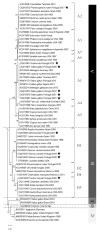Snapshot of the Phylogenetic Relationships among Avian Poxviruses Circulating in Portugal between 2017 and 2023
- PMID: 38133244
- PMCID: PMC10747575
- DOI: 10.3390/vetsci10120693
Snapshot of the Phylogenetic Relationships among Avian Poxviruses Circulating in Portugal between 2017 and 2023
Abstract
Avipoxvirus (APV), a linear dsDNA virus belonging to the subfamily Chordopoxvirinae of the family Poxviridae, infects more than 278 species of domestic and wild birds. It is responsible for causing avian pox disease, characterized by its cutaneous and diphtheric forms. With a high transmission capacity, it can cause high economic losses and damage to the ecosystem. Several diagnostic methods are available, and bird vaccination can be an effective preventive measure. Ten APV-positive samples were analyzed to update the molecular characterization and phylogenetic analysis of viruses isolated in Portugal between 2017 and 2023. A P4b gene fragment was amplified using a PCR, and the nucleotide sequence of the amplicons was determined using Sanger sequencing. The sequences obtained were aligned using ClustalW, and a maximum likelihood phylogenetic tree was constructed. With this study, it was possible to verify that the analyzed sequences are distributed in subclades A1, A2, B1, and B3. Since some of them are quite similar to others from different countries and obtained in different years, it is possible to conclude that there have been several viral introductions in Portugal. Finally, it was possible to successfully update the data on Avipoxviruses in Portugal.
Keywords: Avipoxvirus; molecular characterization; phylogenetic analysis; portugal; viral introduction.
Conflict of interest statement
The authors declare no conflict of interest.
Figures


References
-
- Murphy F.A., Gibbs E.P.J., Horzinek M.C., Studdert M.J. Veterinary Virology. 3rd ed. Academic Press; San Diego, CA, USA: 1999.
LinkOut - more resources
Full Text Sources

